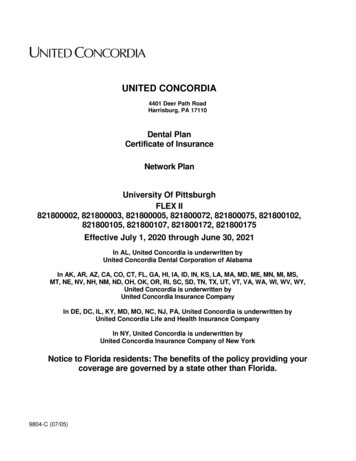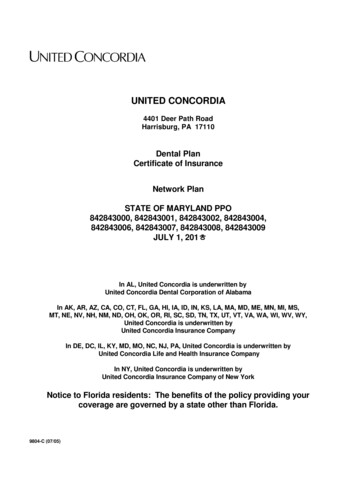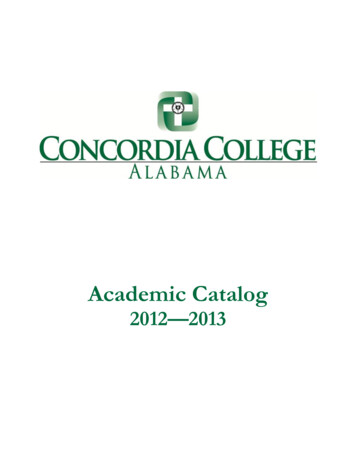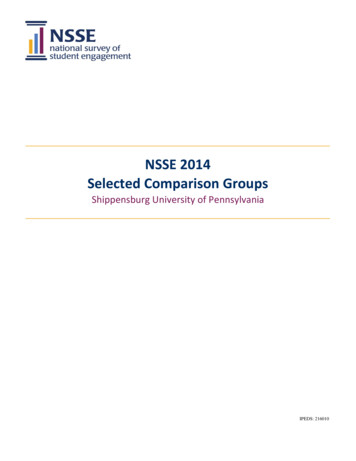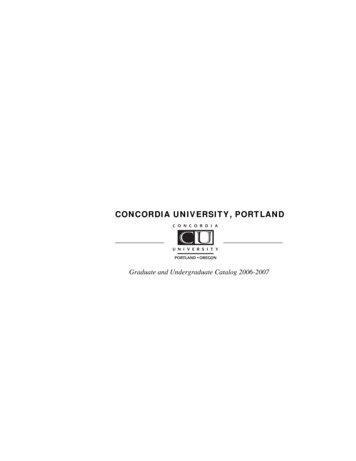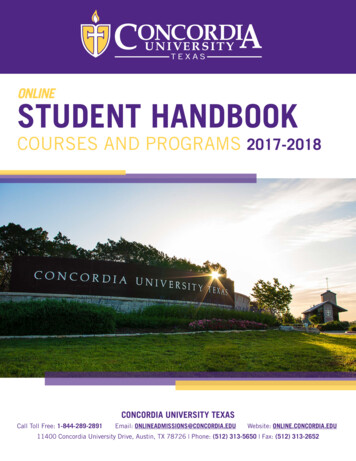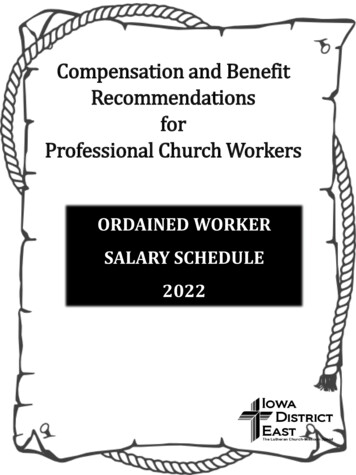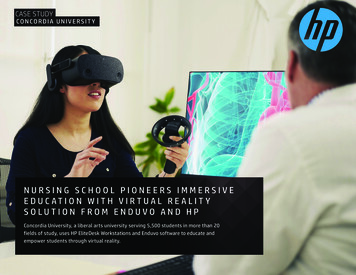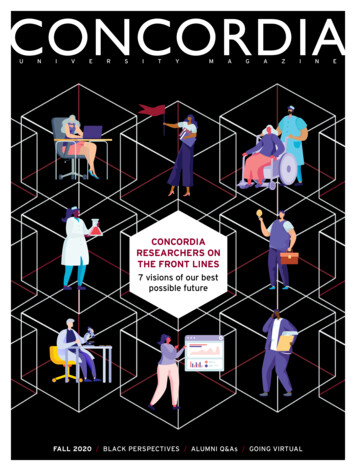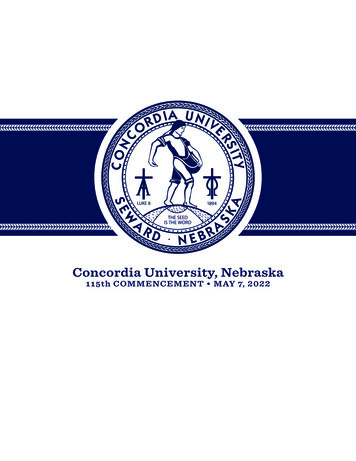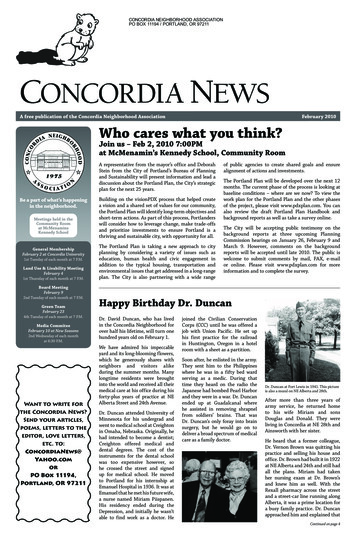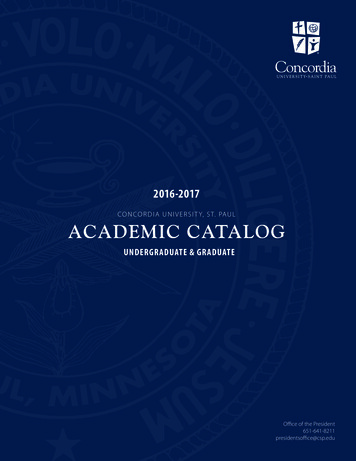
Transcription
2016-2017C O N C O R D I A U N I V E R S I T Y, S T. PAU LACADEMIC CATALOGUNDERGRADUATE & GRADUATEOffice of the President651-641-8211presidentsoffice@csp.edu
ACADEMIC CATALOGConcordia University, St. PaulUndergraduate and Graduate2016 – 2017 (123rd academic year)From the Office of the PresidentDear Friends:A comprehensive& coeducationalLutheran university.Founded in 1893, Concordia Universityis located in the Midway neighborhoodof Saint Paul, Minnesota. The universityoperates under the auspices of TheLutheran Church – Missouri Synod, andcurrently grants the following degrees:Bachelor of Arts, Bachelor of Science,Bachelor of Business Administration,Bachelor of Fine Arts, Master of Arts,Master of Science, Master of BusinessAdministration, Educational Specialist,Doctor of Education, and Doctor ofPhysical Therapy.Table of ContentsUniversity Information.1-14Campus Map. 5Academic Calendars.6-7Legal Notices.11-12Admission Information.14-18NCAA Eligibility. 19Tuition & Fees.20-23Financial Aid/Scholarships.23-29Student Services/Activities.29-34University Organization/Faculty.35-40Undergraduate Academic Info.40-54Majors/Minors.54-80Graduate Academic Information.81-83Graduate Programs.84-88Course Descriptions. 89-137Concordia University, St. Paul1282 Concordia AvenueSt. Paul, MN 55104-5494Switchboard: (651) 641-8278Toll Free: (800) 333-4705TTY: (651) 641-8406Fax: (651) 603-6320www.csp.eduWe are so pleased that you are interested in Concordia University,Saint Paul!If you are a prospective student and are looking at our catalogfor the first time, we hope you are planning to visit our campusto introduce yourself and tell us about your personal needs andaspirations for a college education. Even though we have not metyou yet, we believe in you and your God-given potential. If youare already a Concordia University student we look forward to continuing with you onyour journey of self-discovery and increasing knowledge and skills. We are committedto empowering you to take hold of your purpose for your life and career, as well as theunique opportunities to serve others, which will come your way in the decades ahead.In the pages of this catalog, you can begin to get to know us, especially theoutstanding undergraduate and graduate academic programs of our College of Arts& Letters, College of Business & Technology, and College of Education & Science. Iam very proud of our curriculum and the evidence of expertise and commitment toquality that it carries. I am confident that you would receive a superb education in theacademic programs we offer at Concordia University, but even more I am confidentyou will find both a challenging and nurturing environment in which to study.We remain committed to providing access to academic excellence at an affordableprice. Concordia is recognized as one of the great values in higher education in all ofMinnesota. We strive to offer an outstanding, student-centered learning environmentwhere the Christian faith provides the context for intellectual inquiry and academicpursuits. Whether you are preparing for your first professional job, the next step on analready developing career, or further study in the graduate school of your choice, weare here to help. As a campus providing and requiring access to electronic technology,our students do research and communicate in ways that prepare them for futuretechnological advances. In addition, we are located in one of the great metropolitanareas in the world, in the heart of a city where persons of virtually every race, creed,religion and color have converged to pursue personal goals and community progress.On behalf of the faculty, staff, students and thousands of successful graduates ofConcordia University, Saint Paul, I invite you to examine our programs, visit ourcampus and join us in the wonderful world of inquiry and learning.Rev. Dr. Thomas K. RiesUniversity PresidentThe Concordia University Board of Regents operates Concordia University as an institution of higher education.All information in this Academic Catalog was current at the time of publication. However, the information in this catalog doesnot constitute a contract between Concordia University and the student. The material contained in this catalog is for informationonly. The university reserves the right to make changes in curricula, admissions policies and processes, tuition and financial aid,academic standards and guidelines, student services and any other regulations or policies set forth in this catalog without givingprior notice. All questions may be referred to the Office of Academic Affairs. Concordia University, Saint Paul, is registered as aprivate institution with the Minnesota Office of Higher Education pursuant to sections 136A.61 to 136A.71. Registration is not anendorsement of the institution. Credits earned at the institution may not transfer to all other institutions of higher education.Copyright 2016, Concordia University, Saint Paul
LOGOUNIVERSITY MISSIONThe Concordia University, Saint Paul logo is in theform of a window symbolizing Christian highereducation as a window on life. Framed within thewindow, a cross emerges, which identifies Christas the center of life. The asymmetrical windowand cross reflect that life is not always logical orconsistent, but Christ holds all things together. Thefour complementary colors represent harmony indiversity and harmony in Christ.The mission of Concordia University, a university of the Lutheran Church –Missouri Synod, is to prepare students for thoughtful and informed living, fordedicated service to God and humanity, and for the enlightened care of God’screation, all within the context of the Christian Gospel.This mission is achieved when students pursue programs grounded in theliberal arts and focused on education for vocation in home, workplace,community, and congregation.Cross The cross portrays our mission to educate students in the contextof the Christian Gospel. The Good News of Jesus Christ forms thebasis of life and education at Concordia.Quill The quill is taken from our academic seal and represents ourtradition and commitment to academic excellence and the love oflearning.Individual The individual represents our serving the individual student whileencouraging their personal development and responsibility theeducation process. The outstretched arms imply reaching out toothers, openness to community.Globe The globe reminds us of our world community and Christ’scommand to teach all nations. It also reflects our concern forenlightened care of God’s creation, which is part of our missionstatement.THE CONCORDIA SEALThe Concordia University seal was originally designedby Dr. Theodore Buenger for Concordia College in1895. The Lamp of Learning symbolizes the lightof the knowledge of God’s Word illuminating theminds of the students as well as the darkness of theworld. The Crossed Quills symbolize the writings ofthe student and the writings of the great individualsthroughout history form which the student learns.The Moccasin Flower symbolizes the State ofMinnesota and the beauty of God’s creation. The inscription places learningin the context of the Christian Gospel. Dr. Buenger used the Latin language inkeeping with the classical ideals characteristic of our school: In litteris proficerevole, malo diligere Jesum. This may be translated, “I wish to be proficient inacademics, but even more I wish to know Jesus.” It is based on Ephesians 3:19:“And to know the love of Christ that surpasses knowledge.”Therefore, the university pursues the following purposes: To relate human learning and experience to the Christian faith as thisfaith is confessed within its Lutheran heritage; To provide education within the context of a global perspective; To structure personalized and integrated learning experiences inwhich students share with faculty the responsibility for their ownintellectual, physical, social, emotional, and spiritual growth; To offer a variety of experiences in and out of the classroom designedto assist students in acquiring greater self-understanding, in achievinga growing realization of their abilities and interests, and in investigatingoptions for service in home, workplace, community, and congregation.VISION AND VALUESThe vision of Concordia University, Saint Paul is to be acknowledged as theleading Lutheran university offering exceptional opportunities for studentsfrom all backgrounds who seek relevant career preparation and a challengingacademic experience coupled with the insights of Lutheran theology.MOTTOIn litteris proficere volo malo diligere Jesum“I wish to be proficient in academics, but even more I wish to know Jesus.”PROMISE TO STUDENTSConcordia University, St. Paul empowers you to discover and engageyour purpose for life, career and service in a dynamic, multicultural, urbanenvironment where Christ is honored, all are welcome, and LutheranConvictions inform intellectual inquiry and academic pursuits.COLLEGE PROFILETypePrivate not-for-profitComprehensive, CoeducationalAffiliationThe Lutheran Church – Missouri SynodLevelFour-year or aboveUndergraduate Instructional ProgramProfessions focus, some graduate coexistenceGraduate Instruction ProgramPost-baccalaureate professional (education dominant)Enrollment ProfileMajority undergraduateUndergraduate ProfileFull-time four-year, selective lower transfer-inStudent Population (headcount)4,380 (Fall 2015)Student Population (full-time equivalent)3,777 (Fall 2015)Size and SettingSmall four-year, primarily residential; urbanBasicMaster’s Colleges and Universities (larger programs)Concordia University Academic Catalog3
HISTORY OF THE UNIVERSITYUNIVERSITY CONTACT INFORMATIONConcordia University was founded in 1893 to provide a Christian learningenvironment for high school students preparing to enter the professionalministries of The Lutheran Church – Missouri Synod. In the ensuingdecade, Concordia continued to grow, adding a fourth year of highschool and by 1921 had added the freshman and sophomore collegeyears. The change made it possible for Concordia High School students toremain at their high school alma mater to complete their first two yearsof college work before transferring to a Concordia Senior College wherethey would finish their studies in the church professionsor teaching.This catalog is designed to provide information about ConcordiaUniversity, its curriculum, its academic policies and procedures, and othermatters of interest to students, faculty and staff. Further inquiries may beaddressed to the appropriate office at Concordia. Contact informationfor specific offices, departments, or individual faculty or staff are availableon the university website at www.csp.edu.Concordia College admitted its first class of female students in fall 1950 –much to the delight of the young men on campus and to the dismay ofcoeducational opponents who predicted a significant drop in academicachievement. Despite this new “distraction,” students continued to excelin their studies. Concordia College entered a decade of intense expansionand growth. The college began granting Associate in Arts degrees in1951 and earned accreditation as a two-year college in 1959.Concordia College expanded its curriculum in 1962 to include a four-yearcollege degree and awarded its first Bachelor of Arts degrees two yearslater. By 1967, Concordia had earned accreditation for its four-year liberalarts program, which allowed the college to join the Minnesota PrivateCollege Council. At this time, Concordia High School officially separateditself from the college, moved to its suburban location and adopted itsnew name, Concordia Academy.Concordia College responded to a growing need for minority teachersin the public schools by forming Metropolitan Teacher EducationProgram Selection (MTEPS), which enrolled African-American and otherunder-represented students in a program designed to supplementthe curriculum with scholarship support, personal counseling, tutoringas needed, academic planning and similar services. The program wasreformed in 1983 as the Southeast Asian Teacher (SEAT) LicensureProgram, which serves Hmong and other minority populations in asimilar fashion.A major curricular development in 1985 changed the Minnesotaeducation landscape with the formation of a pioneering programthat allowed students to complete their B.A. degree in an accelerated,one course at a time, format. In 1990, an accelerated M.A. programwas added.As Concordia moved into the new millennium, the institutionimplemented a number of important changes that would reflectthe changing needs of the students, the church and the community.Foremost among these was restructuring that enabled Concordia tobecome a university. In 1997, Concordia College became ConcordiaUniversity, Saint Paul, and adopted the semester system.Concordia College and University PresidentsTheodore Henry Carl BuengerMartin A. H. GraebnerWilly August PoehlerHarvey A. StegemoellerGerhardt Wilfred HyattAlan Frederick HarreJohn Franklin JohnsonRobert Arthur HolstThomas K. 984-19881989-19901991-20112011-presentACADEMIC AFFILIATESAmerican Association of Colleges of Teacher Education (AACTE)Association of Independent Liberal Arts Colleges forTeacher Education (AILACTE)Association of Collegiate Business Schools and Programs (ACBSP)Concordia University System (CUS)Commission on Accreditation of Allied HealthEducation Programs (CAAHEP)Council of Independent Colleges (CIC)Higher Learning Commission (HLC)Midwestern Association of Graduate Schools (MAGS)Minnesota Association of Colleges of Teacher Education (MACTE)Minnesota Department of Education (MDE)Minnesota Office of Higher Education (OHE)Minnesota Private College Council (MPCC)National Association for Education of Young Children (NAEYC)Council for the Accreditation of Educator Preparation (CAEP)National Council for Family Relations (NCFR)The university also developed its current mission and vision statementsand refined its strategic priorities. Today, three colleges and two schoolscomprise Concordia University: the College of Arts & Letters, the Collegeof Business & Technology, the College of Education & Science, the Schoolof Continuing Studies, and the School of Graduate Studies.Concordia University continues to grow to meet the needs of students,the church and the community, while at the same time holding steadfastits historical values and mission.Concordia University Academic Catalog4
q Arndt Science Halla E.M. Pearson Theatre2) Luther Hall2 Pearson Commonsw Bob Barnes Fields Frandrei Center2! Lutheran Memorial Center2& Poehler AdministrationBuildinge Buenger Education CenterAdmissions: LMC 100Financial Aid: LMC 100Registrar: LMC 119d Frauenshuh AmphitheatreBookstore: BEC 102Help Desk: BEC 100f Gangelhoff Center2* Sea Foam Stadium2( Thompson Hallr Buetow Music Centerg Graebner Memorial Chapel2@ Martha Hallt Carlander Fieldh Holst Hall2# Marshall Building3) Winget StudentLife Centery Central Midway Buildingj Hyatt Village2 Mary Hall3! Wollaeger Hallu Center for Hmong Studiesk The Knoll2% Meyer Halli Concordia Art Centerl Kohler Buildingo Cross of Christ Fellowship Center; Library Technology CenterSecurity: MH 124Advising: MH 114Mailroom: MH 128Hamline Ave StationGRIGGS STREETSYNDICATE STREET NORTHHAMLINE AVENUE NORTHTo GreenlineCentralMidwayParkingyBIGELOW AVENUEST. ANTHONY AVENUE949494949494CONCORDIA AVENUELot ELot H3)d;a2#2&q2)2@ 2 Lot Cwi2(fTDAYTON AVENUEJIM KELLEY FIELD& DUNNING FIELDMARSHALL AVENUEHAMLINE AVENUE NORTHALBERT STREEtLot F2%jMARSHALL AVENUELot DuCARROLL AVENUErHOLIDAYSTATIONLot Gog2 ekHIGHER GROUNDACADEMYh3!SYNDICATE STREET NORTHLot HLot BLot BLot HsAVENUE NORTHHAMLINEHAMLINE AVENUENORTH2*Lot A2!AAdmissions OfficeLutheran Memorial CenterGreen LineHamline Ave StationDAYTON AVENUElPedestrain BridgeAdmissions Office651. 641. 8230Conference& Event ServicesConnecting Griggs Street651. 641. 8201Metro Bus StopSecur ityYOU ARE HERESELBY AVENUEGRIGGS STREETA651. 641. 8777SELBY AVENUEConcordia University Academic Catalog5
ACADEMIC CALENDARSTraditional Undergraduate Academic Calendar2016-2017Traditional Undergraduate Academic Calendar2017-2018 (Proposed)FALL SEMESTER 2016August 26-August 28Move in days/Welcome “Week”August 29, MondayClasses begin for all traditional undergraduate studentsSeptember 2, Friday-Last day to add a full semester courseLast day to add or drop a first half semester course without recordSeptember 5, Monday- Labor DayNo ClassesSeptember 12, Monday Last day to drop a full semester course without recordOctober 3, Monday Last day to withdraw from a first half semester course (W)October 13-16, Thursday–SundayFall breakOctober 17, MondayClasses resume;October 19, WednesdayMidterm/end of first half semester coursesDeadline for requesting a P-NOctober 24, MondaySecond half semester courses beginOctober 28, FridayLast day to add or drop a second halfsemester course without recordNovember 9, Wednesday Last day to withdraw from a full semester course (W)November 19-November 27, Monday–SundayThanksgiving breakNovember 28, MondayClasses ResumeDecember 2, FridayLast day to withdraw from a second halfsemester course (W)December 16, FridayClasses endDecember 19–22, Monday–ThursdayFall semester finalsDecember 23, FridayResidence hall move out dayDecember 28, WednesdayGrades DueDecember 24, 2016 –January 8, 2017Semester breakFALL SEMESTER 2017August 25-August 27Move in days/Welcome WeekendAugust 28, MondayClasses begin for all traditional undergraduate studentsSeptember 1, Friday-Last day to add a full semester courseLast day to add or drop a first half semester course without recordSeptember 4, MondayLabor Day-No ClassesSeptember 11, Monday Last day to drop a full semester course without recordOctober 2, Monday Last day to withdraw from a first half semester course (W)October 13-15, Friday–SundayFall breakOctober 16, MondayClasses resume;October 18, WednesdayMidterm/end of first half semester coursesDeadline for requesting a P-NOctober 23, MondaySecond half semester courses beginOctober 27, FridayLast day to add or drop a second half semester coursewithout recordNovember 7, TuesdayLast day to withdraw from a full semester course (W)November 22-November 26, Wednesday–SundayThanksgiving breakNovember 27, MondayClasses ResumeNovember 29, WednesdayLast day to withdraw from a second halfsemester course (W)December 8, FridayClasses endDecember 11–14, Monday–ThursdayFall semester finalsDecember 15, FridayResidence hall move out dayDecember 20, WednesdayGrades DueDecember 16, 2017 –January 7, 2018Semester breakSpring Semester 2017January 9, 2017, MondayClasses beginJanuary 13, FridayLast day to add a full semester courseLast day to add or drop a first half semester course without recordJanuary 16, MondayMartin Luther King Day, No ClassesJanuary 23, MondayLast day to drop a full semester course without recordFebruary 13, MondayLast day to withdraw from a first half semester course (W)February 27, MondayMidterm/end of first half semester coursesDeadline for requesting a P-NMarch 1, WednesdaySecond half semester courses beginMarch 7, TuesdayLast day to add or drop a second halfsemester course without recordMarch 11-19, Saturday-SundaySpring BreakMarch 27, MondayLast day to withdraw from full semester course (W)April 11, Tuesday Last day to withdraw from a second half semester course (W)April 13 – April 17, Thursday-MondayEaster breakApril 18, MondayClasses resumeAprilAcademic Honors Convocationto be announcedApril 28, FridayClasses endMay 1-4, Monday–ThursdaySpring semester finalsMay 5, FridayResidence Hall Move Out DayMay 5-6Baccalaureate Service and Commencement Ceremoniesto be announcedMay 10, WednesdayGrades DueSpring Semester 2018January 8, 2018, MondayClasses beginJanuary 12, FridayLast day to add a full semester courseLast day to add or drop a first half semester course without recordJanuary 15, MondayMartin Luther King Day, No ClassesJanuary 22, MondayLast day to drop a full semester course without recordFebruary 12, Monday Last day to withdraw from a first half semester course (W)February 23, FridayMidterm/end of first half semester coursesDeadline for requesting a P-NFebruary 24 – March 4, Saturday- SundaySpring BreakMarch 5, MondaySecond half semester courses beginMarch 9, FridayLast day to add or drop a second halfsemester course without recordMarch 23, FridayLast day to withdraw from full semester course (W)Last day to withdraw from a second half semester course (W)March 29 – April 2, Thursday-MondayEaster breakApril 3, MondayClasses resumeApril - Academic Honors Convocation – to be announcedApril 27, FridayClasses endApril 30 - May 3, Monday–ThursdaySpring semester finalsMay 4, FridayResidence Hall Move Out DayMay 4 – 5Baccalaureate Service and Commencement CeremoniesMay 9, WednesdayGrades DueSummer School 2017May 15, Monday – June 30, FridayMay 29, Monday – Memorial DayJuly10, Monday – August 25, FridayJuly 1, Saturday – July 9, SundaySummer Session #1 (7 weeks)Offices closed, no classesSummer Session #2 (7 weeks)Holiday week, no classesSummer School 2018May 14, Monday – June 29, FridayMay 28, Monday – Memorial DayJune 30, Saturday – July 8, SundayJuly 9, Monday – August 24, FridayConcordia University Academic CatalogSummer Session #1 (7 weeks)Offices closed, no classesHoliday week, no classesSummer Session #2 (7 weeks)6
C A L E NDAR FOR COH ORT- DELIVERED PROGRAMS2016-20172017-2018 (Proposed)Semester OneCohort Course 1) Monday, September 5 – Friday, October 21Cohort Course 2) Monday, October 24 – Friday, December 16(Nov 19-27 No Chat Week)Semester OneCohort Course 1) Monday, September 4 – Friday, October 20Cohort Course 2) Monday, October 23 – Friday, December 15(Nov 18 – 26 No Chat)Semester TwoCohort Course 1) Monday, January 9 – Friday, February 24Break Week: Monday, February 27 – Friday, March 3Cohort Course 2) Monday, March 6 – Friday, April 28(April 8 – 16 No Chat Week)Semester TwoCohort Course 1) Monday, January 8 – Friday, February 23Break Week: February 24 – March 4Cohort Course 2) Monday, March 5 – Friday, April 27(March 24 – April 1 No Chat)Semester ThreeCohort Course 1) Monday, May 15 – Friday, June 30Cohort Course 2) Monday, July 10 – Friday, August 25Semester ThreeCohort Course 1) Monday, May 14 – Friday, June 29Cohort Course 2) Monday, July 9 – Friday, August 24ACCREDITATIONUNIVERSITYConcordia University, Saint Paul, is accredited by The Higher LearningCommission (HLC) and is a member of the North Central Association ofColleges and Schools (NCA). The University has been accredited since 1967,with re-accreditation given in 2008. The current accreditation is through 2018.North Central Association of Colleges and Schools, Higher LearningCommission, 30 North LaSalle Street,Suite 2400 Chicago, IL 60602-2504; (312) 263-0456.Concordia University is a member of the Council for Higher EducationAdministration (CHEA). A national advocate and institutional voice forself-regulation of academic quality through accreditation, CHEA is anassociation of 3,000 degree-granting colleges and universities andrecognized 60 institutional and programmatic accrediting organizations.Any current or prospective student may request a copy of the documentspertaining to the university’s accreditation or approvals by contactingthe Office of Academic Affairs. In addition, the following programs holdspecialized accreditations and approvals:FAMILY LIFE EDUCATION PROGRAMSThe National Council on Family Relations (NCFR) has fully accredited boththe undergraduate and graduate programs in Family Life Education. TheNCFR provides certification for the profession of family life education.Thus, students who complete the undergraduate or graduate FLEprograms are eligible for certification as a Family Life Educator (CFLE).The NCFR undergraduate re-accreditation was completed in 2014 and isin place through 2019. The graduate re-accreditation was completed in2015 and is in place through 2020.National Council on Family Relations, 1201 West River Parkway,Suite 200, Minneapolis, MN 55454; (888) 781-9331.MASTER OF SCIENCE IN ORTHOTICS AND PROSTHETICS PROGRAMThe master of science in Orthotics and Prosthetics is accredited by theCommission on Accreditation of Allied Health Education Programs(www.caahep.org) upon the recommendation of the NationalCommission on Orthotic and Prosthetic Education.Commission on Accreditation of Allied Health Education Programs1361 Park StreetClearwater, FL 33756727-210-2350www.caahep.orgNURSING PROGRAMSAccreditation of the Nursing Program by the HLC and CCNE is currently inprocess.PHYSICAL THERAPY PROGRAMThe doctorate in Physical Therapy program was granted Candidate for Accreditationstatus in August, 2014 by the Commission on Accreditation in Physical TherapyEducation (CAPTE). The status will be reviewed again in 2017.Commission on Accreditation in Physical Therapy Education (CAPTE)American Physical Therapy Association1111 North Fairfax Street, Alexandria, VA 22314-1488(800) 999-2782.TEACHER EDUCATION PROGRAMSAll professional teacher education licensure programs have been accredited by theNational Council for Accreditation of Teacher Education (NCATE) since 1969. TheCollege of Education & Science at Concordia University is accredited with probationby the Council for the Accreditation of Educator Preparation (CAEP) for a periodof 2 years, from fall 2015 to fall 2017. The accreditation does not include individualeducation courses that the EPP offers to P-12 educators for professional development,re-licensure, or other purposes.Additionally, all teacher licensure programs are approved by the Minnesota Board ofTeaching with the most recent approval completed in 2015 and through 2022.All graduate programs in education are fully accredited by the National Council forAccreditation of Teacher Education (NCATE).National Council for Accreditation of Teacher Education2010 Massachusetts Avenue, NW, Suite 500,Washington, DC 20036-1023; (202) 466-7496Council for the Accreditation of Educator Preparation, 1140 19th Street,NW, Suite 400, Washington, DC 20036; (202) 223-0077.Minnesota Board of Teaching, 1500 Highway 36 West,Roseville, MN 55113-4266; (651) 582-8833.Concordia University Academic Catalog7
ENROLLMENT (FALL, 2015 CENSUS)University HeadcountUniversity Fulltime EquivalentTraditional Undergraduate HeadcountTraditional Undergraduate Fulltime EquivalentDegree Completion Undergraduate HeadcountDegree Completion Undergraduate Fulltime EquivalentGraduate HeadcountGraduate Fulltime Equivalent4380377714211331114667518131771COLLEGES AND SCHOOLSCollege of Arts & LettersCollege of Business & TechnologyCollege of Education & ScienceSchool of Continuing StudiesSchool of Graduate StudiesACADEMIC DEGREESBachelor of Arts (B.A.)Bachelor of Fine Arts (B.F.A.)Bachelor of Science (B.S.)Bachelor of Science in Nursing (B.S.N.)Bachelor of Business Administration (B.B.A.)Master of Arts (M.A.)Master of Arts in Teaching (M.A.T.)Master of Business Administration (M.B.A.)Master of Fine Arts (M.F.A.) *seeking HLC ApprovalMaster of Science (M.S.)Educational Specialist (Ed.S.)Educational Doctorate (Ed.D.)Doctor of Physical Therapy (D.P.T.)GRADUATE PROGRAMSBusiness Administration (M.B.A.)Business Administration with Cybersecurity emphasis (M.B.A.)Business Administration with Health Care Management emphasis (M.B.A.)Creative Writing (M.F.A.) *seeking HLC approvalCriminal Justice Leadership (M.A.)Classroom Instruction with Reading Endorsement (K-12) (M.A.)Cybersecurity Risk Management Certificate (mo M.B.A.)K-12 Reading Endorsement (no M.A.)Differentiated Instruction (M.A.)Doctor of Education (Ed.D.)Doctor of Physical Therapy (DPT)Early Childhood (M.A.)Educational Leadership (M.A.)Educational Specialist (Ed.S.) in Educational LeadershipEducational Technology (M.A.)Exercise Science (M.S.)Family Science (M.A.)Human Services with emphasis in Forensic Mental Health (M.A.);certificate also availableHuman Resource Management (M.A.)Information Technology Management (M.S.) *seeking HLC approvalLeadership and Management (M.A.)Orthotics and Prosthetics (M.S.)Public Policy (M.A.) *seeking HLC approvalSport Management (M.A.)Strategic Communication Management (M.A.)Special Education (Emotionally Behaviorally Disordered; Specific LearningDisabilities; Autism Spectrum Disorder) (M.A.)Teaching (M.A.T. with K-6 Teaching License)UNDERGRADUATE PROGRAMSMAJORS – TRADITIONAL UNDERGRADUATE(Bachelor of Arts unless noted)Accounting (B.S., B.B.A.)Applied Science and Mathematics (B.S.)Art Education/Teaching (Grades K – 12)Art StudioBiology (B.A. and B.S.)Business ManagementChemistryChemistry Education/Teaching (Grades 9 – 12)Child Learning and DevelopmentChristian Ministry (with either DCE or DCO certification)Church MusicCommunication Arts and Literature Education/Teaching (Grades 5 – 12)Communication StudiesCommunity ArtsCommunity Health ScienceComputer Science (B.S.)Criminal JusticeDirector of Christian Education – see Christian Ministry majorDirector of Christian Outreach – see Christian Ministry majorDirector of Parish Music – see Church Music majorEarly Childhood Education/Teaching (Birth – Grade 3)Education – Teaching Licensure and Endorsement ProgramsArt Education/Teaching – see Visual Art Education Teaching Major (K – 12)Chemistry Education/Teaching (Grades 9 – 12)Communication Arts and Literature Education/Teaching Major (Grades 5 – 12)Commun
Concordia University, Saint Paul, I invite you to examine our programs, visit our campus and join us in the wonderful world of inquiry and learning. Rev. Dr. Thomas K. Ries University President The Concordia University Board of Regents operates Concordia University as an institution of higher education.
